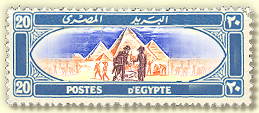The rates of postage of the Napoleonic Post within Egypt have now been largely clarified, as the result of research in the archives by Kurt Wolfsbauer1. Two sets of rates were found: one denominated in sols (= 5 centimes) and an apparently later set, denominated in "parats" (said to be 1/8 sol), showing the rates according to distance The change probably occurred after the Head Paymaster, Sucy, left Egypt with Napoleon, and Daure took over, November 21st, 1799. The tables have some obvious gaps (not all offices are shown), unfortunately, but it is unlikely that any further information will come to light. The two sets are shown in Tables 1 and 2.
The earliest known date for a handstamped office name is 19 October, 1799 (original book, p. 6). This is more than a year after the occupation of Egypt, and one wonders how letters were marked and charged in the interim. Letters without markings as to rate and origin have less interest to philatelists, and therefore might have been overlooked or discarded, and would not be found in collections. Now a letter from this period has been found; it has no markings of any kind, a fact that suggests that prior to ca. October, 1799, origin and rate markings were not used. The military handstamps used after the landing in 1798 , consisting of but single devices, could not have been used for the additional offices (other than Alexandria and Cairo) that were opened, and in general would not have been appropriate after the military campaign was finished (September 1798), and a form of civil administration developed
|

